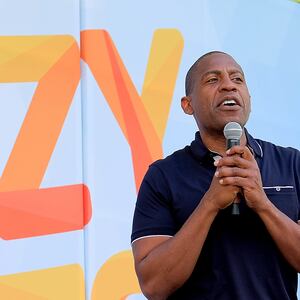Over the past week, Ozy has gone from a seemingly successful media startup to a now-shuttered colossal wreck, thanks to a New York Times exposé and subsequent reporting from other outlets suggesting Ozy may have been built on deception.
The reporting on Ozy management’s broad array of alleged misbehavior has raised the question: How did the company, which launched in 2013, avoid serious scrutiny for so long?
The Daily Beast spoke with more than a dozen current and former Ozy employees, many of whom pointed to Ozy founder and CEO Carlos Watson’s efforts to stifle dissent both internally and externally. A spokesperson for Ozy did not respond to a request for comment for this story.
ADVERTISEMENT
Staffers spoke of a hesitance to go public with concerns about workplace culture or the alleged health of the company because of stringent non-disclosure agreements they had signed with Ozy—an unusual measure for a journalistic outfit. Insider and CNN both reported this week on how staffers felt the company has operated as a “cult of Carlos,” with the founder both allegedly bullying and charming employees into working 18-hour days and keeping internal doubts to themselves.
And Watson appeared to have success in combating negativity from other media outlets as well.
In 2019, Ozy pitched a piece about its annual Ozy Fest to Inc. magazine, a business-focused publication known for its tips and advice for startups, managers, and business owners. But in this instance, Inc. caught wind of a frustrating, low-morale work environment at Ozy, where many staffers were demoralized by long hours and verbal beratement from some managers. (Multiple outlets this week reported as much.)
As a reporter from the publication continued to investigate, Watson worked aggressively to convince the magazine not to publish its reporting, going as far as flying to New York to meet in person with Inc. brass to implore them to scrap the story. The ploy apparently worked; top editors at Inc. became convinced that they did not have sufficient sourcing to run any story at all.
Inc. disputed that Watson’s efforts convinced higher-ups not to publish, instead saying the outlet did not feel comfortable with its own sourcing at the time. “This is absolutely inaccurate. Inc. was pursuing a potential story on the company that didn’t pan out because people were unwilling to go on the record,” a spokesperson wrote in an email to The Daily Beast. Asked whether the magazine regretted not publishing its story, in light of subsequent stories reporting similar concerns about Ozy’s workplace culture, the spokesperson reiterated that Inc. had “only rumor and no sources willing to speak on the record.”
Other outlets were apparently less persuaded by Watson’s charm.
In late 2017, BuzzFeed News published a detailed and damning report about a number of digital publishers that were buying fraudulent web traffic. The primary focus of the story was Ozy, which had just announced a major $35 million investment and boasted major advertisers including JPMorgan Chase, Amazon, and Visa. The reporting detailed how Ozy purchased a service that “automatically loads specific webpages and redirects traffic between participating websites to quickly rack up views without any human action.”
The story set off alarm bells inside Ozy, and multiple sources told The Daily Beast that Watson even called then-editor-in-chief Ben Smith to try and dissuade BuzzFeed News from publishing. While Watson was ultimately unsuccessful in stopping the piece, there was one small victory for Ozy: The company managed to convince BuzzFeed to hold off on publishing how Ozy’s traffic appeared to have been coming from at least one pornographic website. (Several outlets reported this week on Ozy’s questionable means of obtaining web traffic.)
And Watson wasn’t above shutting down elements of his own company’s reporting. For example, Insider reported this week, according to a former editorial staffer, Watson killed an Ozy story when it mentioned one of the company’s own investors.
The digital-media startup’s public unraveling—which culminated Friday with Ozy’s board shutting down the entire operation—began last weekend when The New York Times reported that chief operating officer Samir Rao impersonated a YouTube executive during a fundraising call with Goldman Sachs officials. The bank was reportedly suspicious of the presentation when an undercover Rao overinflated the performance of Ozy’s videos on the streaming platform. (The Times further reported that law-enforcement officials are investigating the call.)
Watson blamed the deceptive ploy on the mental-health struggles of Rao, who was asked to take a leave of absence pending an investigation by outside law firm Paul, Weiss, Rifkind, Wharton and Garrison LLP. But following the Times report, a bevy of other questions involving Ozy’s marketing, fundraising, workplace, and partnerships emerged—largely centered around The Carlos Watson Show, a daily interview show hosted by the namesake CEO and founder.
For example, as The New York Times reported, Watson and Rao insisted to the show’s producers that it would be distributed by A&E, a claim used to entice celebrities like actor Terry Crews and writer Malcolm Gladwell to sit down for interviews. The Carlos Watson Show’s executive producer Brad Bessey quit when he discovered the program was not, in fact, set to broadcast on A&E, writing in a scathing note to Watson and Rao: “You are playing a dangerous game with the truth. The consequences of offering an A&E show to guests when we don’t have one to offer are catastrophic for Ozy and for me.”
Nevertheless, Watson continued to tout that the show would run on A&E and at one point claimed it would become a YouTube Original—a special status for programming paid for by the video-streaming giant. When the show finally debuted, however, it was merely hosted on Ozy’s own YouTube page.
Elsewhere, Ozy used misleading marketing tactics to promote Watson’s show and the media company to the greater public. One advertisement labeled the show “the most important show of 2020,” a quote attributed to the Los Angeles Times even though the newspaper could not find any record of that praise being written by its reporters or columnists. Another ad labeled Watson “the best interviewer on TV,” citing the entertainment outlet Deadline when, in fact, that quote came from Ozy executives themselves. A splashy MTA bus ad for Watson‘s show declared him to be “Anderson Cooper meets Oprah”—high praise attributed once again to the LA Times when it came from Ozy’s own paid content.
Bloomberg reported that Ozy has faced several lawsuits over allegedly failing to pay a firm it hired to inflate its web traffic and for defaulting on a hefty small-business loan from Regis Capital Group, a Florida-based direct lender. And several outlets further reported that Ozy appeared to serve as a branding exercise for Watson, a former MSNBC personality, and, as such, resulted in an allegedly abusive workplace with intense pressure to produce at an exceedingly unrealistic level.
Ozy hired an outside crisis PR firm this week as advertisers and investors bailed and key figures including former BBC reporter Katty Kay and board chairman Marc Lasry resigned. But the damage was done and Ozy is no more.








